Living in Northeast Ohio and saw some birds but are not sure which ones they were?
Ohio is known for its wildlife and according to the Ohio Bird Records Committee (OBRC), there are over 440 species of birds in the state.
Examples of birds of Northeast Ohio include the northern cardinal, eastern kingbird, American robin, trumpeter swan, bald eagle, killdeer, and many others.
Songbirds like the tufted titmouse, raptors like the American kestrel, woodpeckers like the hairy woodpecker, ducks like the wood duck, and other birds are also common in northeastern parts of Ohio.
Some of these birds, like the northern cardinal and the tufted titmouse, will stay year-round there, while others, like the eastern kingbird, will migrate south when the winter comes.
Here are their photos and some fun facts.
Table of Contents
Northeast Ohio Birds
Northern Cardinal

Scientific name: Cardinalis cardinalis
Lifespan: 3 years
Wingspan: 10-12 in
The northern cardinal has been a state bird of Ohio since 1933. It is a beautiful bird with an orange bill that can be seen year-round in Northeast Ohio.
Northern cardinals are common in woodlands, brushy fields, parks, and other urban areas – something northeast Ohio has in abundance. They are also familiar sights in many backyards.
To attract northern cardinals to your bird feeder, make sure to add some sunflower seeds, peanut hearts, millet, or milo.
Northern cardinals are sexually dimorphic – males and females look different.
You will recognize males by their bright red plumage, crests on their heads, and black throats and faces. Females are mostly brown with crests and reddish wings and tails and have no facial masks.
They are also known as redbirds and they get their red color from the food they eat – if there are not enough carotenoids in their food, they become brownish.
Listen for their two-or-three-second song which is a loud string of clear down-slurred or two-parted whistles that sound like “cheer cheer,” “birdie birdie,” and “wheet wheet.”
These birds are very territorial and aggressive – northern cardinals will often try to attack their reflections in the mirrors and windows.
They are omnivores that feed on seeds, fruit, and insects. Northern cardinal’s main predators in Northeast Ohio are cats, barred owls, long-eared owls, Cooper’s hawks, and snakes.
In case you notice male cardinals with baldness problems – it’s a sign they’re in the middle of a late summer molt.
These songbirds are also monogamous and mate for life. Their nesting season starts around April.
Eastern Kingbird
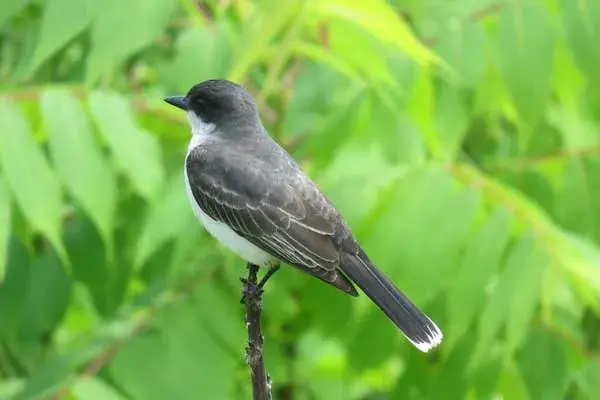
Scientific name: Tyrannus tyrannus
Lifespan: up to 11 years
Wingspan: 13-15 in
Eastern kingbirds are medium-sized songbirds you will see in Northeast Ohio from spring to fall. They usually nest in the state from May to June.
Eastern kingbirds are easy to notice by their slaty plumage above that is white below, white bands at the tip of their tails, and dark caps.
Look for eastern kingbirds around open country, farms, fields, and parks, and listen for their high-pitched “kit-kit” and “dzee-dzee” calls.
They will often perch on wires, watch for large insects, and make quick flights to snatch them. Eastern kingbirds are omnivores and will also feed on berries and fruit, mainly during winter.
After spending summer here, these Ohio songbirds will migrate south to spend winter in South America, primarily northwestern Amazonia.
Eastern kingbirds are very aggressive and if another bird enters their territory, even a larger one, they will attack fiercely. Neither hawks nor crows are safe from them.
They are also one of our many examples of black and white birds found in Colorado.
Black-capped Chickadee

Scientific name: Poecile atricapillus
Lifespan: 2-3 years
Wingspan: 6-8 in
Black-capped chickadees are small backyard birds that can be seen year-round in Northeast Ohio. They nest in the state from early April to mid-May.
Black-capped chickadees are the state birds of Massachusetts and Maine in the US and the provincial birds of New Brunswick in Canada.
They are hard to miss with their short necks, large heads, black caps and bibs, and gray wings that are edged with white patches.
You will commonly find them around the woodlands, forests, and gardens of Ohio.
As the name suggests, black-capped chickadees got named for the black caps on their heads and the distinctive “chickadee-dee-dee” calls.
They are also one of the more useful birds in the orchard or forest as they eat different pests, including insect eggs, larvae, weevils, lice, sawflies, and also some snails, slugs, and spiders.
Pairs are usually monogamous and may remain together for several breeding seasons. In the early spring, the male will even feed the female.
These nonmigratory songbirds might visit your backyard feeder.
If you want to enjoy black-capped chickadees’ inquisitive behavior and friendly demeanor, make sure to add sunflower seeds, peanuts, suet, peanut butter, and mealworms to your feeder.
House Wren
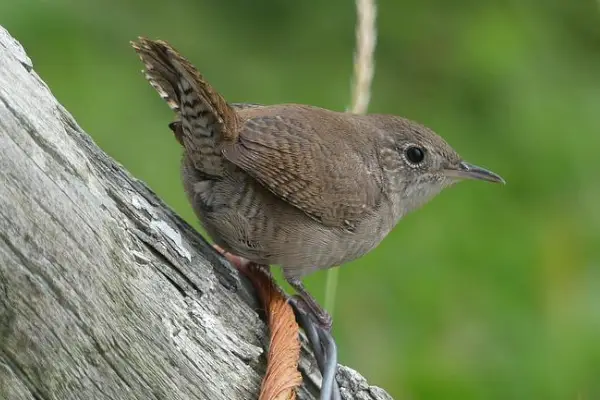
Scientific name: Troglodytes aedon
Lifespan: up to 7 years
Wingspan: 6 in
House wrens are common backyard birds of Northeast Ohio. They are summer residents in the state with April to October being the best months to look for them.
House wrens arrive in the state around March; their breeding season begins at the end of April and lasts until June.
Look for them around weedy areas, fields, and brush piles, and listen for their rush-and-jumble songs. House wrens will often make different harsh sounds: churrs, chatters, rattles, and scolds.
You will also identify these small songbirds by their flat heads, curved beaks, pinkish or gray legs, and short tails that are usually held cocked.
House wrens usually have subdued brown plumage with blackish barrings on their wings and tails.
They got their name due to their tendency to nest around human homes. To attract house wrens to your backyard, make sure to leave piles of brush or put up a nest box.
There are 32 subspecies of house wrens in total.
They might never visit your bird feeder but house wrens might fly through your backyard hunting insects.
Among other places, these birds are also common in Northern California and central parts of Florida.
Red-eyed Vireo
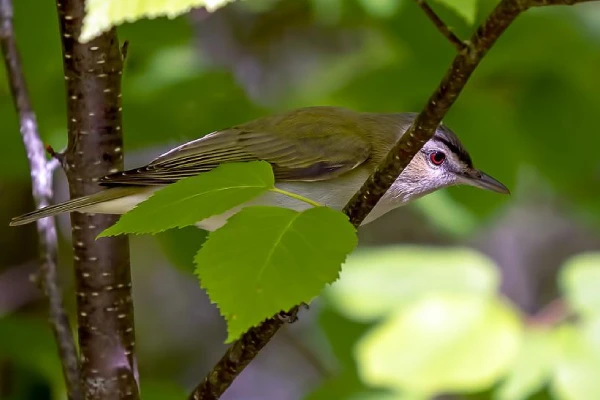
Scientific name: Vireo olivaceus
Lifespan: up to 10 years
Wingspan: 9-10 in
Red-eyed vireos are common residents of Northeast Ohio. You will find them in many habitats, from forests to gardens.
Look for birds with mostly olive-green upperparts, white underparts, red eyes, and a grey crown edged with black. Red-eyed vireos also have thick blue-grey legs and stout bills.
These tireless singers will usually sit high up in the trees and emit different sounds – scientists even recorded one red-eyed vireo singing 117 different types of songs!
They are omnivores and usually feed on insects and berries. Males will feed in the high canopy, while females forage lower down.
They usually breed from mid-April to August and the males are the first to arrive at the breeding grounds in mid-March to establish territories.
After pairing, females will build the nests (males do not help) and lay a clutch of three to five spotted eggs. Both parents will feed the chicks.
These small songbirds are susceptible to brood parasitism – in one instance, scientists found one red-eyed vireo female incubating four eggs of other birds; there were no vireo eggs in its nest as the other bird had punctured or pitched out the vireo’s eggs.
Read More: List of songbirds in Florida
Tufted Titmouse
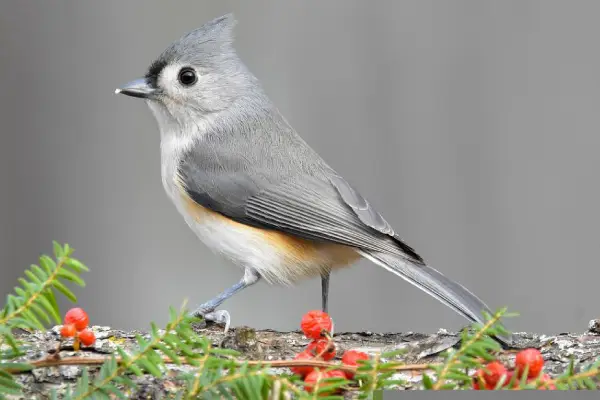
Scientific name: Baeolophus bicolor
Lifespan: 2 years
Wingspan: 8-10 in
Common in areas ranging from forests and parks to suburbs, the tufted titmouse is a permanent resident in Northeast Ohio.
You will recognize this small songbird by its gray plumage, black eyes, a spot on the forehead, and a head crested with fawn flanks.
Listen for the tufted titmouse’s song that people usually describe as a whistled “peter-peter-peter.”
Some estimates claim that there are over 8 million of these birds in existence today.
The tufted titmouse is an omnivore that feeds on berries, nuts, seeds, fruits, and insects.
It is a common visitor to bird feeders where the bird first scouts a feeder from cover, flies in to grab a seed, and then flies back to cover to eat it.
Tufted titmice are cavity nesters that will build their nests in tree holes, nest boxes, or even in old woodpecker nests. If they find snake skin, they might use it as a building material.
American Redstart
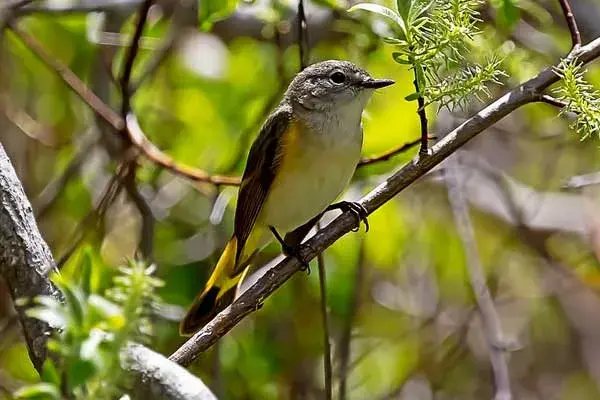
Scientific name: Setophaga ruticilla
Lifespan: up to 10 years
Wingspan: 6.3-9.1 in
American redstarts are lively warblers with relatively wide, flat beaks and fairly long tails.
These medium-sized birds can be often seen hopping among tree branches in search of insects. They are one of North America’s most recognizable wood-warblers and can be seen in habitats ranging from forests to suburbs.
You will recognize female American redstarts and immature males by their yellow or yellow-orange patches on their tails, wings, and sides; adult males are coal-black with vivid orange patches.
They will quickly open their tails, exposing yellow parts, which will scare the insects, allowing American redstarts to catch them in the air.
In Northeast Ohio, American redstarts can be seen from spring to fall. Listen for their high-pitched notes that end with an accented phrase. Males and females will also use different calls, including sharp, sweet-sounding “chips” and soft “tsips.”
These active songbirds nest from May to June.
American redstarts are mostly monogamous although some males might breed with several females and females will often have offspring that is not fathered by the current partner.
American redstarts have a clutch of two to five eggs. Females build the nests and incubate the eggs while both sexes fed the young.
American Robin

Scientific name: Turdus migratorius
Lifespan: 2 years
Wingspan: 12-16 in
American robins are migratory songbirds and common sights in forests, lawns, and suburbs across Northeast Ohio throughout the year.
Males are easy to identify by their black heads, yellow beaks with gray tips, and brick-red breasts. Females are slightly duller and have brown heads.
Look for large flocks of birds, sometimes up to 10,000 individuals.
Their song is often described as a “cheery” carol; these birds will also sing when storms approach and when they have passed.
American robins are the state birds of Connecticut, Michigan, and Wisconsin.
They are omnivores with a sweet tooth and will feast on fruits, berries, and even cakes and pastry. American robins are omnivores and will also eat earthworms, caterpillars, and insects.
American robins nest in the state from March through June and produce 2-3 broods per year with 3-4 young per clutch.
Cedar Waxwing

Scientific name: Bombycilla cedrorum
Lifespan: up to 8 years
Wingspan: 9-12 in
Northern Ohio’s permanent resident, the cedar waxwing is a medium-sized sleek bird with a large head and a crest, a black facial mask, and a short neck and bill.
It also has pale brown on the head, soft gray on the wings, pale yellow on the belly, and gray with bright yellow tips on the tails.
Cedar waxwing got its name from the waxy red tips on its secondary wing feathers.
This yellow-tailed bird is common in different habitats ranging from deciduous and evergreen woodlands to orchards, suburban parks, and backyards.
The cedar waxwing is one of the few North American birds that can survive eating only fruit for several months. If the bird eats enough of the honeysuckle fruit while it is growing, the tip of the tail will turn from yellow to orange.
Cedar waxwing usually nests in the state around June.
Brown Thrasher

Scientific name: Toxostoma rufum
Lifespan: up to 12 years
Wingspan: 11-13 in
Common around woodlands and gardens of Northeast Ohio from spring to fall, the brown thrasher is a medium-sized bird that weighs less than 3 oz.
As the name suggests, the brown thrasher has brown plumage above that is buffy and heavily speckled below, yellow eyes, light wing bars and tail tips. Males and females look similar.
It has one of the largest repertoires of songs among birds; the brown thrasher can sing over 1,000 types of songs and even imitate other birds.
Brown thrashers are susceptible to brood parasitism where another bird lays eggs in their nests for thrashers to raise.
They nest in shrubs, small trees, or at times on the ground with a clutch of three to five blue-greenish eggs. They are also very aggressive birds that will fiercely protect their nests and territories.
Brown thrashers are omnivores and feed on insects, berries, nuts, seeds, snails, and frogs.
They are state birds of Georgia; read about the other 25 birds found in that state here.
Ovenbird
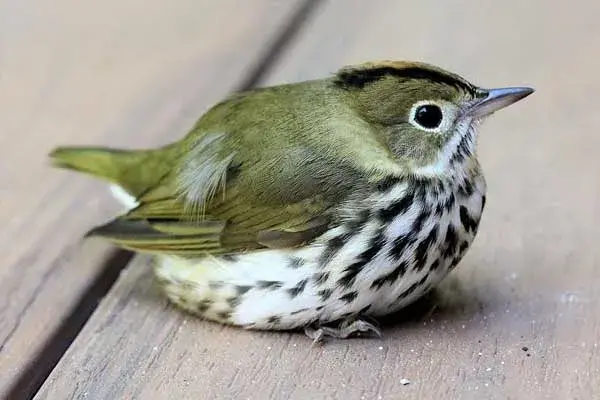
Scientific name: Seiurus aurocapilla
Lifespan: up to 11 years
Wingspan: 7.5–10.2 in
Ovenbirds are small migratory birds that can be seen in the northeastern parts of Ohio from spring to fall. People often mistake them for wood thrushes, but they are warblers.
You will recognize ovenbirds by olive-green upper plumage, black and white underparts, white rings around the eyes, and the black stripe below the cheeks. They also have dark eyes and the upper part of the thin pointed beak, a horn-colored lower beak, and pinkish legs and feet.
They usually walk instead of hopping and often skulk in the forest understory.
Ovenbirds got their name from the nest they build called the “oven” – it is a dome-like structure placed on the ground with a side entrance that makes it resemble a Dutch oven. In Ohio, they build these nests from May to early June.
When a predator is nearby the nest, the female can perform a distraction display and simulate a crippled bird.
Eastern Bluebird

Scientific name: Sialia sialis
Lifespan: 6-10 years
Wingspan: 9-12 in
Although some populations might stay year-round in the state, most of the eastern bluebirds that live in Northeastern Ohio can be seen there only during summer.
The first to return to the state around early March will be the males, going back to the same territories where they previously bred.
You will recognize eastern bluebirds by their big, rounded heads, large eyes, and alert posture.
Male eastern bluebirds are small North American migratory thrushes that have vivid royal blue heads and back plumage and warm red-brown and white breasts. Females have gray plumage above with bluish wings and tails and subdued orange-brown breasts.
Look for them in the open country with scattered trees, farms, and roadsides and listen for their soft melodious warble song and their liquid and musical “turee” or “queedle” call.
Eastern bluebirds are cavity nesters that will often use nest boxes. In case you want to attract one, try placing your nestbox some 40 yards from a wood edge and away from a seed feeding station.
Eastern bluebirds might be also attracted to peanut butter mixes, suet, fruit, raisins soaked in hot water, and mealworms.
They are very social birds living in flocks with over 100 individuals, but also very territorial.
To attract a female, a male bluebird will sing over 1,000 songs per hour; it sings without opening its beak wide. These birds are omnivores that mostly feed on insects, including grasshoppers, crickets, beetles, caterpillars, and some fruit.
The eastern bluebird is the official bird of Missouri and New York.
These birds are also quite common in Maryland, Western Pennsylvania, North Texas, and other places.
Ruby-throated Hummingbird
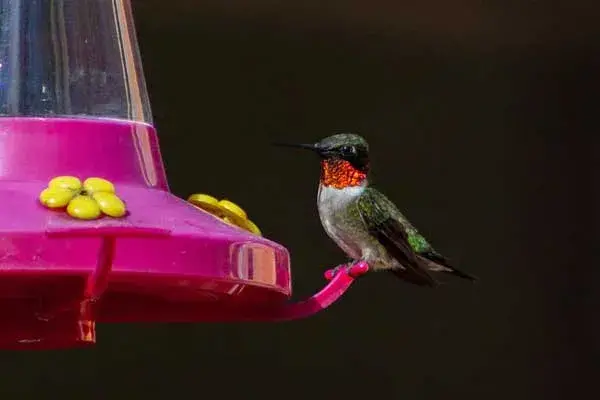
Scientific name: Archilochus colubris
Lifespan: 3-5 years
Wingspan: 3.1-4.3 in
Ruby-throated hummingbirds are beautiful green birds with brilliant iridescent red throats.
You can see them in northeastern parts of Ohio from spring to fall. They are by far the most common hummingbird species in the state.
Males will be the first to arrive, a week or two before the females, usually from late April to early May. They leave towards the end of September; males are also the first to leave the state.
Both sexes look different.
Males have metallic emerald green upperparts, grayish-white underparts, black wings, and a gorget (throat patch) of iridescent ruby red. Their tails are forked.
Females are larger than males, have slightly shorter beaks, and have white throats.
Ruby-throated hummingbirds move very quickly, around 25 mph, and will beat their wing over 50 times per second.
These birds are mostly solitary, except during the breeding season which lasts a few days.
To attract these birds with red throats and necks to your backyard, you can set up hummingbird feeders or plant tubular flowers. They are quite bold and might even feed at hanging plants and feeders on your porch or next to your windows!
Hairy Woodpecker
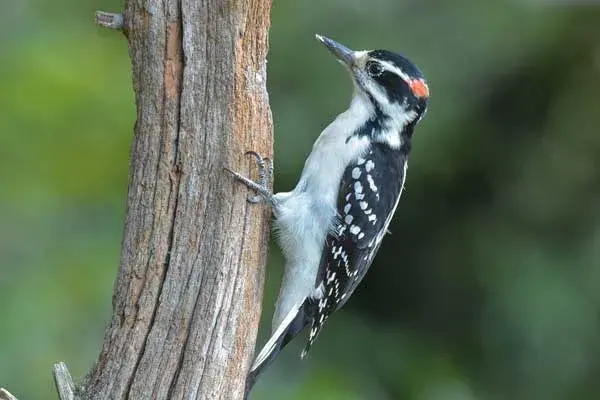
Scientific name: Leuconotopicus villosus
Lifespan: up to 15 years
Wingspan: 13-16 in
These contrastingly black and white woodpeckers can be seen in northeast Ohio year-round in habitats ranging from forests to gardens.
Hairy woodpeckers resemble downy woodpeckers – the main difference between the two is the smaller size and a shorter beak of the downy woodpecker.
Hairy woodpeckers are medium-sized birds that forage along trunks and main branches of large trees.
You will identify them by their black and white plumage, black wings with white patches, two white stripes on the heads, and a large white patch down the center of their black backs.
Hairy woodpeckers got the name “hairy” because of the thread-like white feathers in the middle of their backs.
They play an important role in the ecosystem as they eat the insects that destroy forest trees, saving forests as a result. They also eat some berries, seeds, and nuts.
Thick bones and cartilage that act as a shock absorber allow them to hammer at tree back without injuries, and a tongue twice the size of the beak helps probe trees for insects.
Downy Woodpecker
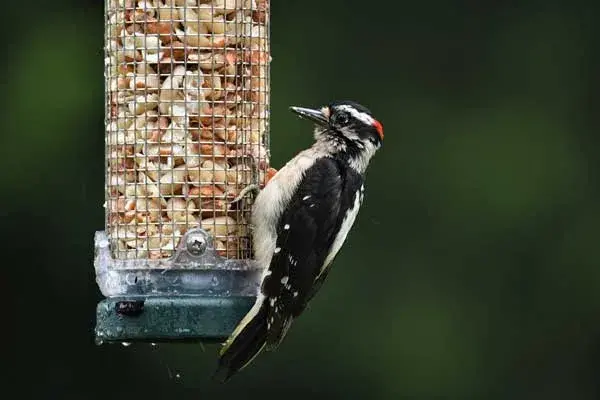
Scientific name: Picoides pubescens
Lifespan: up to 11 years
Wingspan: 10-12 in
Downy woodpeckers are the smallest species of woodpeckers found in Northeastern Ohio.
They look almost identical to the hairy woodpeckers and can be seen throughout the year in the state around open forests of mixed growth, orchards, suburbs, urban woodlots, and parks.
Look for birds with the black color of their upperparts and wings, white backs, throats, and bellies, and white spottings on their wings.
Try to notice the white bar above and below the eyes. Also, adult male downy woodpeckers have red patches on the back of their heads.
Downy woodpeckers have a soft “pik” call and a rattling sound that starts slowly and speeds up at the end, trailing off.
These woodpeckers have special feathers around their nostrils to save them from breathing in wood chips as they hit the tree bark.
Downy woodpeckers are omnivores that mostly feed on insects, beetle larvae, ants, and caterpillars, but also berries, acorns, and grains.
Look for them around bird feeders, they will often eat suet and black oil sunflower seeds and occasionally drink from hummingbird feeders.
Downy woodpeckers are monogamous and the pair will together prepare a nest in the tree. The female will then lay from 3 to 8 eggs.
Barred Owl
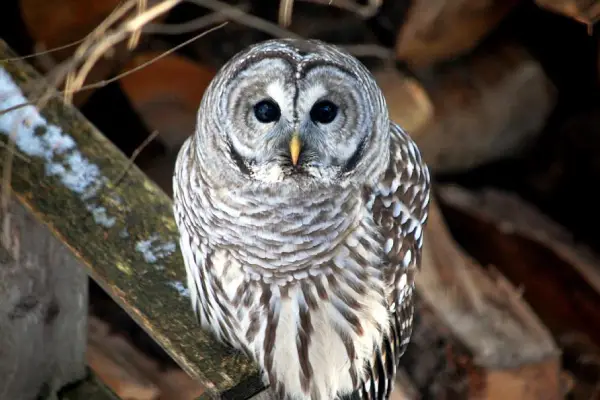
Scientific name: Strix varia
Lifespan: 10 years
Wingspan: 38-49 in
Commonly found in Northeast Ohio throughout the year, the barred owl is a medium-sized monogamous owl that mates for life.
You will hear this spooky-looking bird early in the night, at dawn, and occasionally on cloudy days. Listen for its accented hoots that sound like “who cooks for you, who cooks for you all.”
Source: Jonathon Jongsma, CC BY-SA 4.0, via Wikimedia Commons
The barred owl can be seen mostly around forest swamps, riparian forests, and upland forest habitats. It is also known as the northern barred owl, striped owl, and hoot owl.
In case you see one in person, you will notice the mottled brown plumage, yellow beak, dark eyes, and the absence of ear tufts. The barred owl got its name from a series of darker bars on its chest.
This owl has a sedentary nature and prefers not to migrate. It will rarely build its nest and will use hollow tree cavities instead, including old hawk, squirrel, and crow nests, or some nesting structures people built.
It is a carnivore that mostly hunts at night and feeds on some insects, small mammals, and even crayfish and crabs.
Bald Eagle

Scientific name: Haliaeetus leucocephalus
Lifespan: 20-30 years in the wild
Wingspan: 70.8-90.5 in
The bald eagle is a national bird of the United States that can be found around the marshes, swamps, and river systems of Northeast Ohio.
Accordion to the Ohio Department of Wildlife, the number of bald eagle nests in Northeast Ohio has increased from 61 in 2012 to 136 in 2020.
When looking at the whole state, the eagle population has recovered from a low of just four breeding pairs in 1979 to 806 nests in 2021.
The best time to see bald eagles in full courtship and nest-building mode would be January. Two counties in northeast parts of the state with the most eagles are Trumbull and Ashtabula county.
Look for these awe-inspiring birds sitting perched high above barren trees. Bald eagles are one of the largest raptors in the state and breed there from October to March.
They also build the largest nests of any North American bird that can be up to 13 ft deep and 8.2 ft wide.
You will recognize bald eagles by their commanding presence, white heads and tails, brown color, and bright yellow bills.
Before attaining these characteristics around the age of five, bald eagles are mostly dark brown with varying amounts of white mottling.
Bald eagles are hard to miss as they soar through the air with their 7.5-foot-wide wingspan.
They are carnivores and opportunistic feeders that mostly consume fish, which they snatch from the water with their sharp talons.
They are also one of the largest birds found in Texas, Michigan, and Florida.
Golden Eagle

Scientific name: Aquila chrysaetos
Lifespan: up to 30 years
Wingspan: 70.8-90.1 in
Northeast Ohio is lucky to see another large North American eagle species, the golden eagle.
They might be a rare sight in Ohio but some of the golden eagles that nest in Canada will occasionally winter in the northern parts of the state.
There have been a couple of golden eagle sightings along the Lake Erie shoreline on the coldest of days and during spring and fall migrations.
Golden eagles are migratory birds that mostly move late in fall and early in spring.
They tend to spend more time in southern states during the cooler months of the year.
Golden eagles are one of the largest, fastest, and most agile birds of prey in North America and can be identified by the overall dark brown plumage, with the lighter golden-brown color of their napes.
They are monogamous species that stay together for life and have a clutch of one to three eggs. Golden eagles will often construct nests on platforms on steep cliffs or in large trees.
Their agility and speed together with powerful feet and large, sharp talons allow golden eagles to hunt rabbits, hares, ground squirrels, and other animals like prairie dogs.
American Kestrel

Scientific name: Falco sparverius
Lifespan: 5 years in the wild
Wingspan: 20-24 in
These smallest North American raptors can be seen in Northeast Ohio throughout the year.
You will find American kestrels around the open country including farmland, orchards, and grasslands, looking for grasshoppers, rodents such as mice, shrews and voles, and even small birds.
They are also known as sparrow hawks and they are a sexually dimorphic species (males and females look different).
Males have red, white, and blue plumage with white underparts, bluish wings with white spots, blue heads, and brown-red backs. Females are slightly larger and have rufous wings and backs with dark brown barrings, brown speckled or streaked creamy white underparts, and red-brown tails.
American kestrels have three basic vocalizations – the “klee” or “killy“, the “whine“, and the “chitter“.
Depending on the plumage, size, and vocalizations, there are 17 subspecies of American kestrel.
According to the Ohio Department of Natural Resources, only one of these subspecies, the Falco sparverius sparverius, can be seen in Ohio.
American kestrels are cavity nesters that might occasionally nest in woodpecker holes or abandoned nests of other birds.
Green Heron
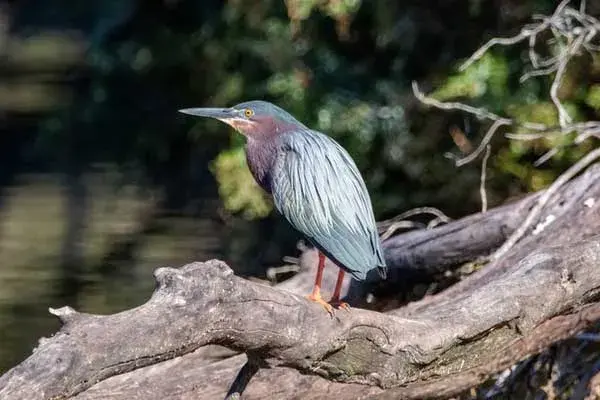
Scientific name: Butorides virescens
Lifespan: up to 8 years
Wingspan: 25-26 in
Green herons are small dark herons commonly found from spring to fall in northeastern parts of Ohio.
They can be seen around lakes, rivers, ponds, and marshes. You will recognize green herons by their long beaks, short necks, and orange eyes. Notice the glossy greenish-black caps, dark green upperparts, gray underparts, white throats, and short yellow legs in adults.
Listen for their loud and sudden “kyow” call.
Green herons are rare bird species that use tools. They will often leave bread crusts, insects, and feathers on the surface of the water to attract small fish, patiently wait for the fish to come, and snatch it with their dagger-like bills.
Green herons also feed on crayfish, other crustaceans, insects, grasshoppers, frogs, rodents, and even snakes.
The American Birding Association selected the green heron as the official Bird of the Year 2015.
American Black Duck

Scientific name: Anas rubripes
Lifespan: up to 26 years
Wingspan: 35-37 in
American black ducks are large ducks with rounded heads, thick bills, and bulky bodies. They are commonly found around wetlands and are permanent residents of Northeast Ohio.
Both sexes look alike. They resemble female mallards a lot, except for their beaks that have dull mustard color. Notice the purple-blue speculum feathers with predominantly black margins, dark tails, and webbed fleshy orange feet.
American black ducks are very gregarious and can be seen in flocks of thousands of birds. They are excellent swimmers and will often dive in order to avoid predators.
They build their nests on the ground and hide them well. American black ducks will have a clutch of 6-14 oval eggs.
They are omnivores and have a diverse diet. American black ducks feed on wetland grasses, sedges, seeds, aquatic plants, mollusks, snails, amphipods, insects, mussels, and small fish.
Wood Duck
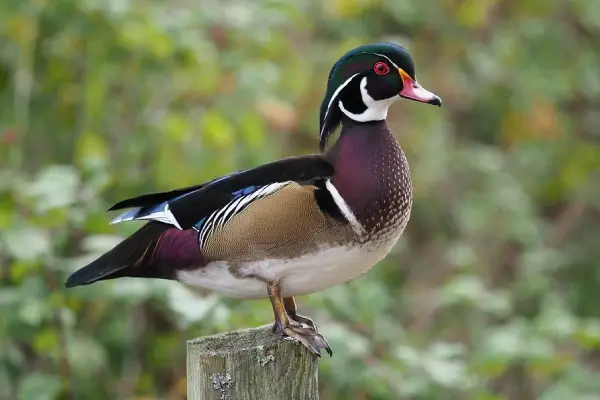
Scientific name: Aix sponsa
Lifespan: 3-4 years
Wingspan: 26-29 in
Wood duck, also known as Carolina duck, is one of the most colorful North American waterfowl.
It is common around the wetlands of Northeast Ohio year-round. Males are multicolored and have red eyes; females are grayish brown and have white eyerings and blue speculum. Both sexes have crests on their heads.
Listen for the male’s rising whistle “jeee” call or the female’s drawn-out, rising squeal that sounds like “do weep do weep.”
The wood duck is a permanent resident of the state and can be seen there year-round.
This species usually nests in cavities in trees close to water; if you put a nesting box, you might be able to attract a pair.
Wood ducks have a clutch of 7-15 white-tan eggs and they are the only North American ducks that can produce two broods in one season.
Their nesting season begins in early May in Ohio.
Wood ducks are omnivores and feed on nuts, seeds, vegetables, berries, and insects.
Killdeer

Scientific name: Charadrius vociferus
Lifespan: up to 11 years
Wingspan: 18-25 in
Killdeer is a large plover that has a slender body, large, round head, large eyes, and a short bill. It is one of the most abundant shorebirds of Ohio, and one of the only shorebirds that breed in the state.
If you live in Northeast Ohio, you will find this bird around wetlands and fields. Killdeer is common from spring to fall in this part of the country.
Look for birds with brown plumage above and two black breast bands. Killdeers also have orange tails, pink legs, and slender wings with conspicuous white wing stripes at their base.
These birds are masters of distraction that might fake a ‘broken-wing‘ where they flutter along the ground in a show of injury, to distract predators from their nests.
Killdeers are omnivorous and feed on insects, including beetles, caterpillars, grasshoppers, fly larvae, spiders, earthworms, centipedes, crayfish, snails, and some seeds.
These conspicuous birds got their name from the loud piercing calls that sound a little like “kill-deer, kill-deer”.
Read More: 25+ East Tennessee Birds
Herring Gull
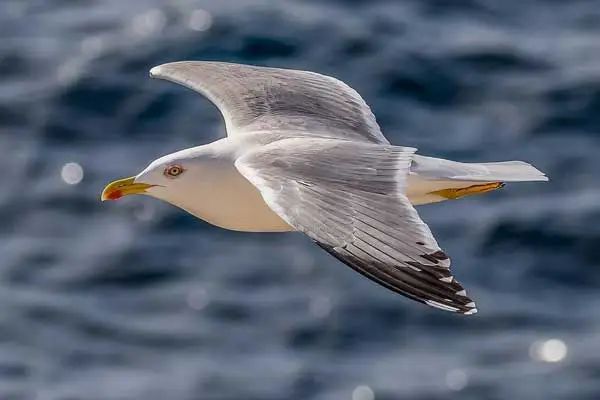
Scientific name: Larus argentatus
Lifespan: up to 50 years
Wingspan: 47-61 in
Herring gulls are winter residents of northeast Ohio. Around lake Erie, these large gulls can be seen year-round.
Look for them around wetlands, towns, and dumps.
Adults are large, light gray with dark wingtips, white irises, and pink legs. Notice their massive beaks with a red spot on the lower mandible.
Herring gulls are the largest gulls in Ohio and the second most likely gulls to be found inland in the state, after the smaller ring-billed gull.
These birds are omnivores, primarily scavengers (like other gulls). They feed on invertebrates, fish, insects, carrion, and human refuse.
Herring gulls are intelligent birds that can be often seen dropping clams and mussels from a height on hard surfaces to open them.
They nest on rocky cliffs and these white birds can be also seen in Hawaii.
Trumpeter Swan
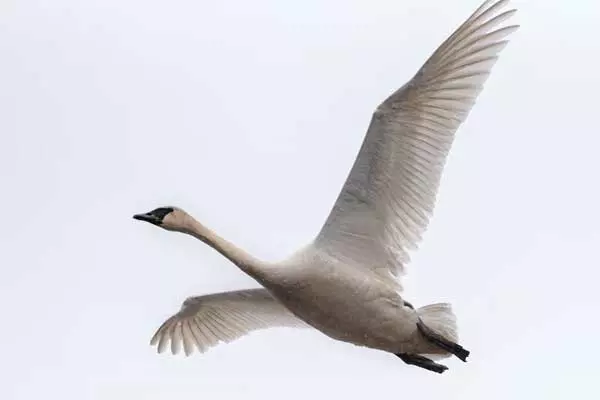
Scientific name: Cygnus buccinator
Lifespan: up to 25 years
Wingspan: 72.8-98 in
Trumpeter swans are the largest swans in Ohio and North America.
Although once widespread in the Great Lakes region, these huge birds were hunted down and wiped out in Ohio hundreds of years ago.
Trumpeter swans were reintroduced to the state about 25 years ago. Thanks to conservation efforts, according to some estimates, the total population of trumpeter swans in Ohio in 2020 was around 650 individuals.
Out of the 98 breeding trumpeter swan pairs noted in 2020, many could be seen in the Lorain, Medina, Summit, Geauga, and Portage counties of Northeast Ohio.
You will best identify trumpet swans by their white plumage and black bills. They are big and North America’s heaviest flying birds that can weigh over 25 pounds.
With a wingspan of up to 98 inches, a length of almost 71 inches, and a weight of up to 30 pounds, trumpeter swans are the largest birds in Ohio.
Trumpeter swans are loud birds and their calls sound similar to a trumpet, which resulted in the specie’s name. They are mostly vegetarians and mainly eat plants found in or near the water.
They might eat insects, small fish, and eggs, but trumpet swans prefer plants overall.
Summary
This concludes our list of birds in Northeast Ohio.
There are several types of birds found in Northeast OH, including many types of songbirds, raptors, woodpeckers, owls, ducks, and many others.
Next time you see any of these birds in person, you should be able to recognize them with ease!
And if you enjoyed our article, here are our other popular reads on birds: List of birds in Southern California and List of stunning black birds with yellow heads